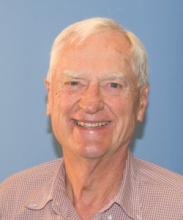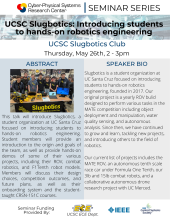CPS Events
Algorithmic system design for safety and resilience of future intelligent transportation systems
Abstract
Please join us this Friday, October 7th for a talk by CPSRC Director Ricardo Sanfelice at the first ever UCSC Interdisciplinary Research Symposium. Ricardo will be discussing algorithmic system design for safety and resilience of future intelligent transportation systems, which is a focus of the ~$6M NSF Frontier project that was recently awarded to him and fellow Baskin faculty Abhishek Halder and Heiner Litz.
Bio
Ricardo G. Sanfelice received the B.S. degree in Electronics Engineering from the Universidad de Mar del Plata, Buenos Aires, Argentina, in 2001, and the M.S. and Ph.D. degrees in Electrical and Computer Engineering from the University of California, Santa Barbara, CA, USA, in 2004 and 2007, respectively. In 2007 and 2008, he held postdoctoral positions at the Laboratory for Information and Decision Systems at the Massachusetts Institute of Technology and at the Centre Automatique et Systèmes at the École des Mines de Paris. In 2009, he joined the faculty of the Department of Aerospace and Mechanical Engineering at the University of Arizona, Tucson, AZ, USA, where he was an Assistant Professor. In 2014, he joined the University of California, Santa Cruz, CA, USA, where he is currently Professor in the Department of Electrical and Computer Engineering. Prof. Sanfelice is the recipient of the 2013 SIAM Control and Systems Theory Prize, the National Science Foundation CAREER award, the Air Force Young Investigator Research Award, the 2010 IEEE Control Systems Magazine Outstanding Paper Award, and the 2020 Test-of-Time Award from the Hybrid Systems: Computation and Control Conference. Prof. Sanfelice is a Fellow of IEEE.
Developing, Designing, and Deploying Model Predictive Control for Satellite Rendezvous and Proximity Operations
Abstract
The process of developing, designing, and deploying algorithms in relevant environments is one that couples theory and application tightly. This is especially prevalent in satellite navigation and control. Deploying these methods requires rigorous theory to ensure confidence that the algorithm will not cause damage to a multi-million dollar asset. However, the application of such methods may require repeated execution on the order of seconds to minutes with minimum memory impact. Such considerations are important to the United States Space Force (USSF) as it strives to remain at the forefront of technology development for future satellite architectures.
This talk will discuss the process of developing, designing, and deploying algorithms, in particular Model Predictive Control (MPC), for satellite rendezvous and proximity operations (RPO). These RPO missions must facilitate numerous requirements. Firstly, the ability to operate in unknown, communication limited environments, such as in geostationary orbit and beyond. Secondly, these algorithms must enable precise, time-critical maneuvering and replanning needed for missions like on-orbit assembly and manufacturing. Some key aspects that will be highlighted throughout the talk are (1) understanding and exploiting underlying spacecraft dynamics (2) how to design algorithms to meet mission needs, and (3) steps to take to ensure that algorithms can be maximized for satellite and operator use. In the context of MPC, this will entail how to develop the optimization problem to ensure stability, robustness, and recursive feasibility while tailoring the methods for real-time feedback control and planning.
Bio
Dr. Dr. Christopher “Chrispy” Petersen is an Assistant Professor at the University of Florida in the Mechanical & Aerospace Engineering Department as of Fall 2023. He leads the Spacecraft Technology And Research (STAR) Laboratory, which is focused on 4 pillars of research; 1) Exploring & exploiting spacecraft dynamics 2) Advanced guidance, navigation, control, and autonomy (GNCA), 3) Real-time, computationally aware optimization for spacecraft and 4) Immersive human-satellite interfaces. While he enjoys everything space, his group’s research focuses primarily in the domains of rendezvous, proximity operations, and docking (RPOD) and eXtra GEOstationary (XGEO, which is above Geostationary orbit, to the Moon, and beyond). Before that, he was at the Space Vehicles Directorate of the U.S. Air Force Research Laboratory (AFRL/RV) located at Kirtland Air Force Base in New Mexico. He received his B.S. from Syracuse University in Aerospace Engineering in 2012, and his M.S. and Ph.D. from University of Michigan in 2016 in Spacecraft Dynamics & Control. While at AFRL he worked on 10+ satellite experiments, developing, deploying, and executing GNCA algorithms for ground and on-orbit use. As a highlight, Dr. Petersen was the PI for advanced autonomous guidance algorithms used by the Mycroft flight experiment which has been recognized as “…the AF’s biggest game changer” for space warfighters. He also served as Deputy Program Manager of the Autonomous Demonstrations and Orbital eXperiments (ADOX) Portfolio, which is a series of satellite demonstrations focused on autonomy technologies to enable satellite inspection, XGEO space domain awareness and logistics in GEO including advanced propulsion and refueling. For his accomplishments, in 2021 he was awarded the AFRL Early Career Award. is an Assistant Professor at the University of Florida in the Mechanical & Aerospace Engineering Department as of Fall 2023. He leads the Spacecraft Technology And Research (STAR) Laboratory, which is focused on 4 pillars of research; 1) Exploring & exploiting spacecraft dynamics 2) Advanced guidance, navigation, control, and autonomy (GNCA), 3) Real-time, computationally aware optimization for spacecraft and 4) Immersive human-satellite interfaces. While he enjoys everything space, his group’s research focuses primarily in the domains of rendezvous, proximity operations, and docking (RPOD) and eXtra GEOstationary (XGEO, which is above Geostationary orbit, to the Moon, and beyond). Before that, he was at the Space Vehicles Directorate of the U.S. Air Force Research Laboratory (AFRL/RV) located at Kirtland Air Force Base in New Mexico. He received his B.S. from Syracuse University in Aerospace Engineering in 2012, and his M.S. and Ph.D. from University of Michigan in 2016 in Spacecraft Dynamics & Control. While at AFRL he worked on 10+ satellite experiments, developing, deploying, and executing GNCA algorithms for ground and on-orbit use. As a highlight, Dr. Petersen was the PI for advanced autonomous guidance algorithms used by the Mycroft flight experiment which has been recognized as “…the AF’s biggest game changer” for space warfighters. He also served as Deputy Program Manager of the Autonomous Demonstrations and Orbital eXperiments (ADOX) Portfolio, which is a series of satellite demonstrations focused on autonomy technologies to enable satellite inspection, XGEO space domain awareness and logistics in GEO including advanced propulsion and refueling. For his accomplishments, in 2021 he was awarded the AFRL Early Career Award.
Developing aerial robotic systems for on-demand wind sensing in the lower atmosphere
Abstract
Developing aerial robotic systems for measuring wind velocity near the Earth's surface is critical for understanding the surface-atmosphere interactions driving the dynamic state of the atmospheric boundary layer (ABL). How the ABL evolves with respect to space and time affects crop health management, air pollutants transport, extreme weather formation, and wildfire spread. However, most conventional sensors do not reach beyond tens of meters above ground level and are often cost-prohibitive and time-consuming to deploy. This talk will present a model-based framework for on-demand and targeted measurements of atmospheric wind flows using aerial robotic systems. The first part of the talk will present a model-based wind sensing framework for aerial robotic systems that leverages flight data-driven modeling and state estimation techniques. The integration of model-based wind sensing and low-cost sensor technology to reduce the uncertainty methane emissions estimates from both dairy farms and oil and gas fields will be discussed in the second part of this talk.
Bio
Javier González-Rocha is a UCR Chancellor’s Postdoctoral Fellow in the Department of Mechanical Engineering. Prior to joining UCR, Dr. González-Rocha earned both a B.S. and M.S. degree in mechanical engineering from CSU-Sacramento, and a Ph.D. degree in aerospace engineering from Virginia Tech. His research leverages system identification, flight dynamic modeling, state estimation, and low-cost sensors to sense wind, turbulence, and air composition within the atmospheric boundary layer using aerial robotic systems. In addition to his research, Dr. González-Rocha is actively engaged with initiatives to increase the participation of historically marginalized communities in STEM fields. For these efforts, Dr. González-Rocha has been recognized with the California State University Louis Stokes Alliance for Minority Participation Award for Outstanding Alumnus & Service/Leadership and the Virginia Tech Aspire Award for Self-Understanding and Integrity.
God does not play dice, Kalman filtering, and phase locked loop dynamics.
Abstract
Optimal recursive system parameter estimation has been applied to a phase locked loop (PLL) since the 1950s. Application to a PLL results in a second order, type II PLL. This type of PLL is NOT robust to parametric variations in the components of a PLL. The cause of this lack of robustness illustrates the main problem with optimal recursive linear system parameter estimation. Solution of this problem can then be extended from commercial PLLs to the general problems encountered in adaptive control, neural networks, neuro-biological information transfer, and the Heisenberg uncertainty principle.
Bio
Since 2000, Don has been teaching and researching at UCSC in both Department of Electrical and Department of Computer Engineering at UCSC, and was a researcher in the Center for Adaptive Optics there (2001 - 2011). Don is a Life Fellow of IEEE. Don retired as Professor of Engineering and Applied Science in the Electrical Engineering Department at UCLA in 1994, after 29 years there. He was also Professor of Anesthesiology at UCLA. In 1995 he served as Senator Tom Harkin’s (Dem. IA) Legislative Assistant in Defense Appropriations, Energy, Environment, Arms Control, and Veteran’s Affairs as IEEE Congressional Fellow. He was a Fulbright Senior Fellow in Denmark in 1976-7 and in Norway in 1983-4, and he visited at DFVLR, Munich, 1969-70, University of Newcastle, Australia, 1989-90, University of Maryland, 1993-94, and Ajou University, Suwan, South Korea, 2006-07.
UCSC Slugbotics: Introducing students to hands-on robotics engineering
Abstract
This talk will introduce Slugbotics, a student organization at UC Santa Cruz focused on introducing students to hands-on robotics engineering. Student members will provide an introduction to the origin and goals of the team, as well as provide hands-on demos of some of their various projects, including their ROV, combat robotics, and F1Tenth robot models. Members will discuss their design choices, competition outcomes, and future plans, as well as their onboarding system and the student-taught CRSN-151C courses.
Bio
Slugbotics is a student organization at UC Santa Cruz focused on introducing students to hands-on robotics engineering, founded in 2017. Our original project is a yearly ROV bulid designed to perform various tasks in the MATE competition including object deployment and manipulation, water quality sensing, and autonomous analysis. Since then, we have continued to grow and learn, tackling new projects, and introducing others to the field of robotics.
Our current list of projects includes the MATE ROV, an autonomous tenth scale race car under Formula One Tenth, our 3lb and 15lb combat robots, and a collaborative autonomous drone research project with UC Merced.






